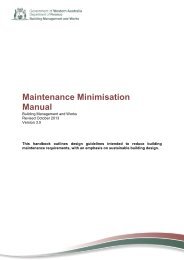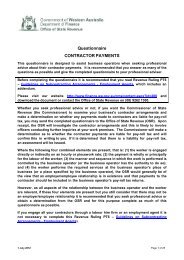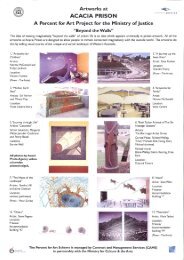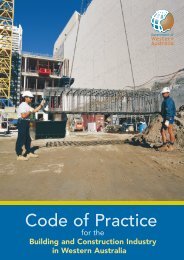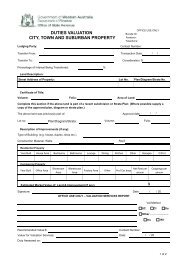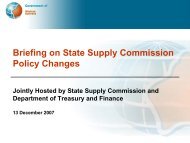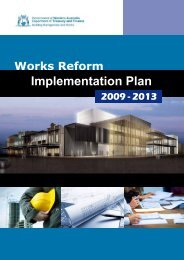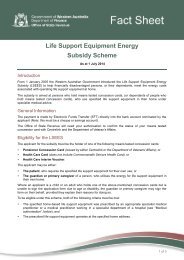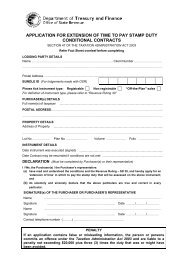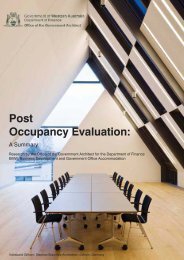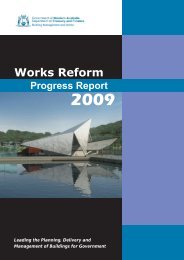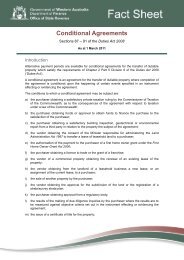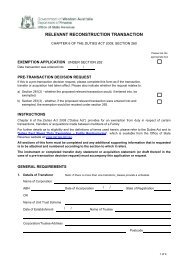Renewable Energy Handbook 2010 - Department of Finance - The ...
Renewable Energy Handbook 2010 - Department of Finance - The ...
Renewable Energy Handbook 2010 - Department of Finance - The ...
You also want an ePaper? Increase the reach of your titles
YUMPU automatically turns print PDFs into web optimized ePapers that Google loves.
State and Australian Government departments andagencies can also be approached to enquire aboutcurrent funding assistance that may be availablefor the project and guidelines.Once all the economic data has been collected,a fi nancial model should be created and a series<strong>of</strong> scenarios envisaged at ensuring an economicallyfeasible project. This is an iterative process andvarious stakeholders may have to be consultedfurther to assist in the analysis.<strong>The</strong> feasibility study should also typically include afuture development strategy that outlines recommendedactions to progress the project through to operation,including a timetable for implementation.3.1.4 PROJECT DESIGNFinalisation <strong>of</strong> Agreements andObtaining Project ApprovalsA key component for any renewable energy projectis the identifi cation and contracting <strong>of</strong> a customerfor energy and other products. This stage allows forthe formalisation <strong>of</strong> the preliminary negotiations fora Power Purchase Agreement (PPA).Securing investment and funding from fi nanciers iscrucial at this stage <strong>of</strong> development. If any additionalfi nancial support is available from government,this should also be secured at this point. Heritage,environmental and planning approvals from relevantgovernment agencies or authorities, such asWestern Australian Planning Commission (WAPC),<strong>Department</strong> <strong>of</strong> Environment (DoE), <strong>Department</strong> <strong>of</strong>Indigenous Affairs (DIA) and local government,will also need to be secured at this stage. Approvalsare discussed in greater detail in sections 3.2 to 3.9.Project Definition Document<strong>The</strong> Project Defi nition Document formally establishesthe parameters that guide the detailed design anddevelopment <strong>of</strong> the project. It typically includes:Technical information such as the type and size <strong>of</strong>·the generating units, how and where the energywill be used on site, how and where the electricityis transferred to the grid and process flow diagrams;Details <strong>of</strong> the formalised Power Purchase Agreement·with an energy retailer or wholesale purchaser;Environmental and planning approvals; and·Investment details including any funding from·fi nanciers if required and support fromgovernment agencies if available.OFFICE OF ENERGYRENEWABLE ENERGY HANDBOOK <strong>2010</strong>3.1.5 IMPLEMENTATION AND OPERATIONIf the Project Defi nition Document is signed <strong>of</strong>fand a decision is made to proceed with the project,formal contractual documentation can then beinitiated and fi nalised. Once all the required contractshave been signed, the detailed design, construction andcommissioning <strong>of</strong> the power station can commence.3.2 Heritage Approval3.2.1 INTRODUCTION<strong>The</strong> development <strong>of</strong> a renewable energy proposalmay impact on areas <strong>of</strong> importance and signifi canceto Aboriginal people. Anyone planning to develop landin a way that might disturb an Aboriginal site shouldbe aware <strong>of</strong> his or her legal obligations under Stateand Commonwealth legislation. <strong>The</strong> law requires thata reasonable effort must be made to fi nd out if anyAboriginal heritage sites exist in the development area.Identifying this issue during early project planningwill help to avoid potentially time-consuming andcostly delays later.A diverse range <strong>of</strong> sites can constitute a heritage site,but essentially sites fall into two broad categories:Archaeological: places <strong>of</strong> material cultural remains·(engravings, artefact scatters); andAnthropological: places <strong>of</strong> spiritual signifi cance·to Aboriginal people (eg. mythological andceremonial grounds).3.2.2 STATE PROCESSESAreas and objects <strong>of</strong> Aboriginal signifi cance areprotected under the State’s Aboriginal Heritage Act1972 (AHA). Prior to the proposed development/activity, it is recommended that suitably qualifi edconsultants be engaged to conduct ethnographicand archaeological surveys <strong>of</strong> the area to ensurethat no site is damaged or altered that would resultin a breach <strong>of</strong> Section 17 <strong>of</strong> the AHA. <strong>The</strong>se surveyswould involve archival research via a search <strong>of</strong> theRegister <strong>of</strong> Aboriginal Sites’ database maintained bythe DIA, a review <strong>of</strong> relevant survey reports as wellas consultations and on-the-ground inspections.31DEVELOPING A RENEWABLE ENERGY PROJECT IN WESTERN AUSTRALIA



